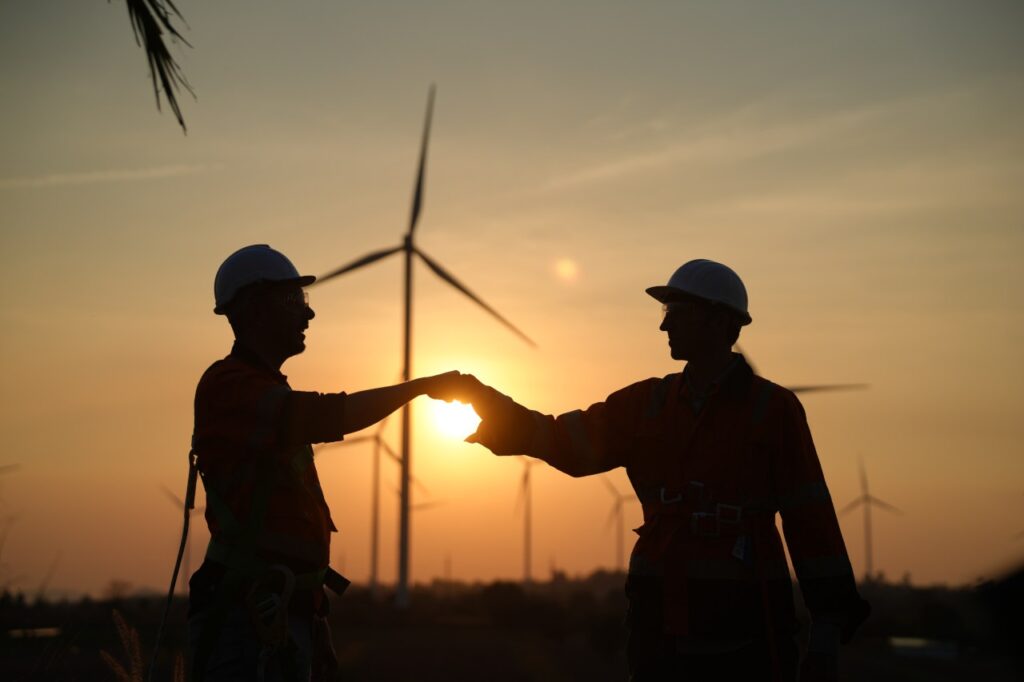Dieser Beitrag ist auch verfügbar auf:
Deutsch
Key barriers to the global energy transition
1. Inadequate infrastructure and grid capacity
One of the key challenges is the modernization and expansion of the existing energy infrastructure. The electricity grids in many countries are not designed for the fluctuating feed-in of renewable energies such as wind and solar energy. Significant investments in smart grids, storage technologies and grid management systems are required to ensure a stable energy supply.
2. Insufficient storage technologies
Renewable energies such as wind and solar energy are highly dependent on the weather, which leads to irregular power generation. Powerful storage technologies such as batteries, pumped storage plants or innovative approaches such as power-to-gas are needed to secure the energy supply even at times when there is no sun or wind.
Power-to-gas (P2G) is a technology in which surplus renewable electricity, for example from wind or solar energy, is converted into gas to be used as an energy storage or carrier. Electricity is used to electrolyze water to produce hydrogen, which can either be used directly or further processed with CO to produce synthetic methane (natural gas).
However, technological progress in this area is expensive and still in its infancy.
3. Inadequate political and regulatory framework conditions
Political support is crucial to the success of the energy transition. Unclear or contradictory legislation, a lack of incentives and slow approval procedures hinder the expansion of renewable energies. In addition, there are strong economic interests in many countries such as Russia, Venezuela and Nigeria that are clinging to the status quo of fossil fuels. Political instability can also delay progress significantly.
4. Insufficient financing and investment
The transition to renewable energies requires vast financial resources. While the cost of solar and wind energy has fallen in recent years, financing remains a challenge, especially for large-scale infrastructure projects. Many developing countries lack the necessary funds and loans, which further widens the gap between industrialized nations and poorer countries.
5. Resource dependency and environmental issues
The expansion of renewable energies requires the use of rare raw materials such as lithium and cobalt as well as rare earths, which are needed for batteries, solar modules and wind turbines. The extraction of these raw materials is often associated with considerable environmental damage and frequently takes place in politically unstable regions. This leads to new dependencies and raises ethical and ecological questions.
6. Insufficient social acceptance
The energy transition is bringing about far-reaching changes in society that are not always met with approval. The construction of wind farms, solar parks or new power lines often meets with resistance from the population, especially when these projects are planned near residential areas. The fear of job losses in traditional industries such as coal mining or oil and gas extraction is also a considerable hurdle.
7. Insufficient global coordination and cooperation
As climate change affects the whole of humanity, the energy transition requires international solidarity. However, different economic interests and priorities as well as unequal levels of development make global coordination difficult.
The Paris Agreement of 2015 was an important step towards the energy transition, but the implementation of concrete measures remains a major challenge, especially in view of geopolitical tensions. The aim of the Paris Agreement is to limit global warming to below 2 degrees Celsius – if possible, to 1.5 degrees Celsius – compared to pre-industrial levels.
8.Insufficient technological advancement and a lack of willingness to innovate
Although renewable energy sources are becoming increasingly efficient, further technological innovations are needed to meet the challenges of the energy transition. These include more efficient solar modules, offshore wind turbines and methods for CO₂ capture and storage (CCS). Research and development in these areas is time-consuming and requires considerable investment.
These pioneers are defying the odds
Several countries have found innovative ways to use renewable energy. These examples illustrate how different countries are using their natural resources to shape the transition to a more sustainable energy future.
1. Denmark: the country that is thriving on wind power
Denmark currently covers around 50 % of its electricity requirements from wind energy – a world record. The country relies on strong citizen participation and innovative technologies.
The largest offshore wind farm financed by citizens
The “Middelgrunden” wind farm near Copenhagen is 50% owned by the residents of the city. Anyone has been able to purchase shares, which has led to broad acceptance and financial participation.
Surplus electricity becomes heating energy
Denmark also utilizes surplus wind energy to heat water in large heat storage tanks. This heat is then used to heat buildings in winter.
2. China: The solar energy giant
China is now the largest producer of solar cells and is investing heavily in renewable energies. Although the country still relies heavily on coal, it has set itself the goal of becoming climate-neutral by 2060.
Floating solar power plants
China has built several floating solar plants on former coal mines. These solar parks make efficient use of the water surface, reduce evaporation and are also less susceptible to overheating.
The “Great Wall of Solar”
In the Gobi Desert, a huge solar plant is being built in the shape of a panda bear. This is intended to raise awareness of renewable energies and symbolizes China’s ambitions in climate protection.
3. Iceland is fully committed to geothermal energy
Iceland covers almost 100% of its electricity needs from renewable energy sources, primarily hydropower and geothermal energy. The country’s volcanic activity makes geothermal energy an ideal source of energy.
Warm water under the streets to combat icy conditions
In Reykjavik, geothermal energy is used to melt snow and ice from the roads in winter. An underground pipe system ensures that the roads remain free of snow and ice, which significantly improves safety and mobility.
The innovative CO₂ absorption and mineralization plant
The “CarbFix” technology developed in Iceland binds CO₂ from the air and turns it into rock. This method is considered groundbreaking for future CO₂ reduction.
4. Morocco: Harnessing solar energy in the desert
Morocco is investing heavily in solar energy and has built some of the largest solar power plants in the world. The country aims to generate 52% of its electricity from renewable sources by 2030.
The Noor power plant
The Noor solar park in the Sahara is the largest solar complex in the world. It uses concentrated solar power (CSP) to generate electricity after sunset by storing heat in molten salt.
Hydrogen from solar energy
Morocco plans to use solar energy to produce green hydrogen, a sustainable fuel for industry and transport.
5. Uruguay: The silent champion in renewable energies
Although Uruguay is a small country, it covers almost 98% of its electricity needs from renewable energies. Within a decade, Uruguay has completed one of the largest conversions in the world, without state subsidies.
A role model for efficiency
Uruguay was able to implement the energy transition in just 10 years, investing primarily in wind energy. The country drastically reduced its carbon emissions and stabilized electricity prices at the same time.
Going green with Google
Uruguay supplies electricity from renewable energy sources for Google’s data centers in South America, further driving demand for green electricity.
6. Australia: Solar energy as a lifesaver in remote areas
Australia is known for its large-scale solar projects, but its use of renewable energy in remote regions is particularly noteworthy.
Solar energy for Aboriginal communities
Solar panels are increasingly being used in remote areas of Australia to provide clean energy to communities that previously relied on diesel generators.
The ‘Tesla battery’
The world’s largest lithium-ion battery, installed by Tesla in South Australia, is helping to stabilize the grid and has already saved millions in costs for grid operators.
7. Germany is a solar and wind giant
Germany is regarded as a pioneer of the energy transition and is heavily focused on wind and solar energy. The promotion of renewable energies through the Renewable Energy Sources Act (EEG) from 2000 has massively accelerated the expansion.
Producing more energy than the grid can absorb
In extremely windy periods, Germany produces so much wind power that the electricity price is negative at times. This means that electricity producers pay consumers to buy the surplus electricity.
Solar power from the roof of an airport
Munich Airport generates around 1.5 megawatts of solar power per year with one of the largest photovoltaic systems on airport roofs – enough to supply around 500 households.
The innovative ION Power Grid system from Salzburg, Austria
The ION Power Grid is a decentralized energy network based on blockchain technology that efficiently integrates renewable energies. It enables peer-to-peer energy trading in which households and companies can sell surplus solar or wind power directly.
The blockchain’s transparent and tamper-proof data processing optimizes energy distribution while reducing dependence on central suppliers. The system promotes the use of local renewable resources and increases grid stability through intelligent, automated control.
What we can learn from energy transition pioneers
A key success factor for the energy transition is the innovative use of local resources, as examples from Iceland and Morocco demonstrate. Iceland relies on geothermal energy thanks to volcanic activity, while Morocco uses the strong solar yield for solar projects. Both countries adapt their energy policy to geographical conditions and make use of their natural advantages.
In addition, community involvement plays a crucial role in the acceptance of energy projects. In countries such as Denmark, public participation has shown that people are more likely to support change if they are involved in the decision-making process and can invest in projects.
Innovation and political commitment are other key factors. China uses floating solar panels, Iceland filters CO₂ from the air and Uruguay shows that political stability enables a rapid transition to renewable energies. These examples illustrate that the energy transition can finally gain momentum through local adaptation, citizen participation and bold investment.






